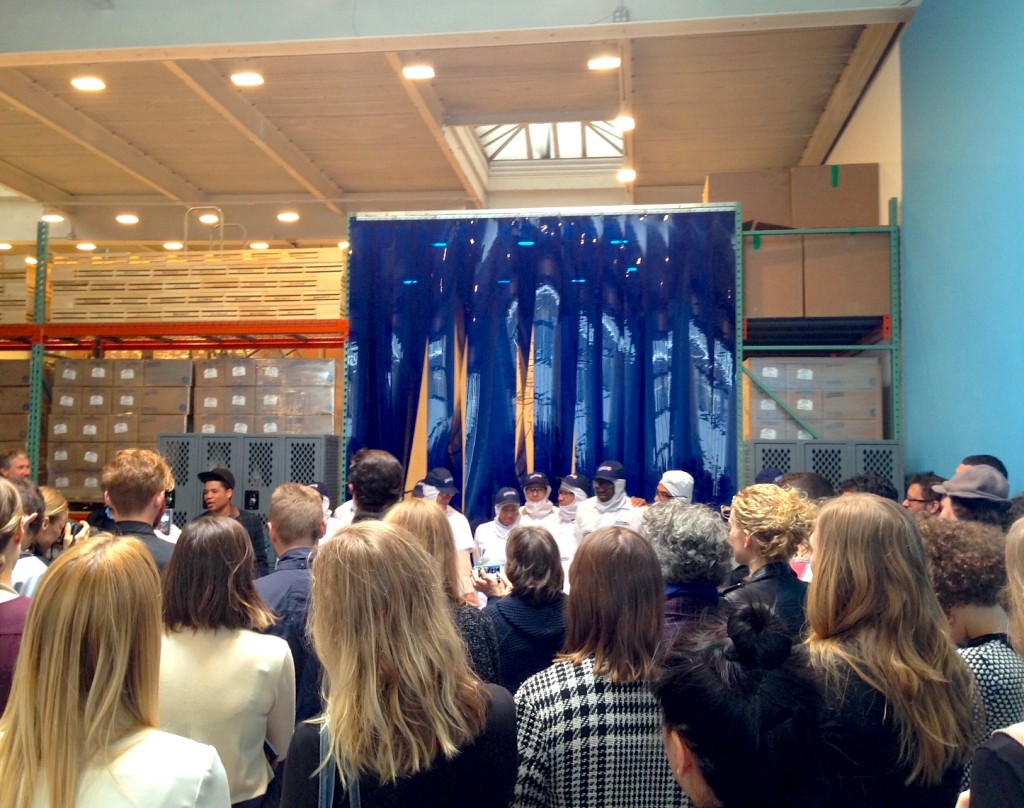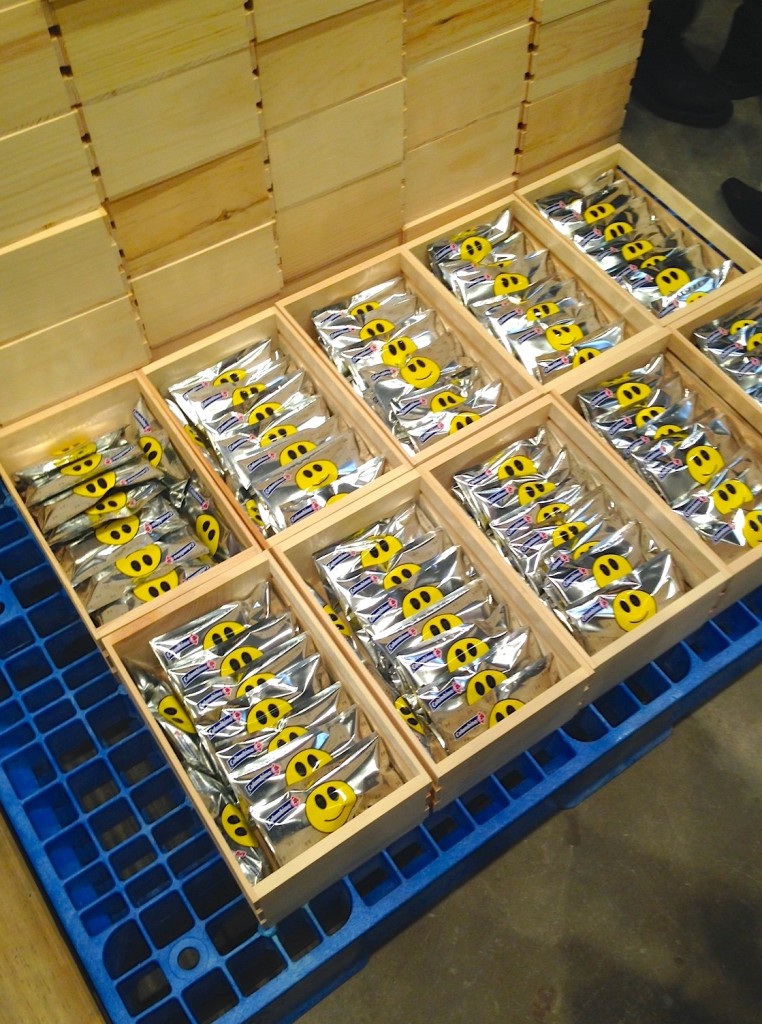
Oscar Murillo, A Mercantile Novel, Press preview, David Zwirner Gallery, NY
Photograph by Katy Hamer, 2014
Oscar Murillo does not consider himself a painter. This was discovered at the tail end of the press preview at David Zwirner for the artists first solo exhibition with the gallery, “A Mercantile Novel” 2014. The beginning of our dialogue went like this.
KATY DIAMOND HAMER: Hi Oscar, good to meet you. Congratulations on the exhibition.
OSCAR MURILLO: Thank you
KDH: I wanted to ask you about painting and how you relate this new work to your [abstract] paintings.
OM: That type of question seems like it would only come from someone who is not familiar with my work.
KDH: Okay. (Feels a bit of blood rush to the cheeks).

Oscar Murillo, A Mercantile Novel, Installation view, David Zwirner, New York
Photograph by Katy Hamer, 2014
OM: Are you familiar with my work?
KDH: The last time I saw [a large quantity of] your work in person was in Miami 2012 in the exhibition at the Rubell Collection. (Note: I have seen the artist’s work since then but in group exhibits and art fairs, not in the context of a solo show.)
OM: Well, that wasn’t really an exhibition. The Rubell familiy has a collection and the work on view was part of that collection. My last exhibition, and first in the US was at The Mistake Room in LA. This isn’t the first time that I’m showing video and I’ve been working with the Colombina Factory for a year now but much of my exposure [for work other than painting] has been outside the US.
KDH: Yes, however many people in the US will make the visual connection between the large abstract paintings and what you are doing now. That is just what happens in contemporary art and the art market in general. Painting is a physical process and I’m just curious as to how you would equate that physicality to the work you have on view in this current show –video and a site-specific installation, including factory workers who are making Colombina candy, a sugary confection of chocolate and marshmallow. Do you think of chocolate as a painterly medium?
OM: (Softening a bit) I don’t consider myself a painter. I don’t want to say that painting isn’t important to me, but it’s not the main part of my practice. I use various media [to communicate a particular story]. I think of this work as having a particular physicality to it, the way it occupies space.
KDH: That makes sense. You are young and still have so much room to expand on what you do as an artist.
OM: Yes.
KDH: I actually like the show and am happy with the change and to see new work.
OM: Thank you.
KDH: I was in Colombia in October, in Bogotá for ArtBO and Medellín. It’s a beautiful country. How long are the workers from the factory here?
OM: They will be at the gallery until the end [of the show], June 14th. A lot of work went into putting this together, not just the money but the logistics, bringing people from the factory in Cali to New York was very complicated. A museum wouldn’t do it and the gallery [David Zwirner] is the perfect place for it.

Oscar Murillo (center,left) and a Colombina factory worker (right), A Mercantile Novel
David Zwirner, New York
Photograph by Katy Hamer, 2014
Oscar Murillo rose to fame in the art world quite quickly. Born in Colombia in 1986 and currently based in London, at 27 years old he has graced the covers of several art magazines (including Flash Art International) and is included in many important collections. David Zwirner has fed the public via art exhibitions before. In a 2007 show with work by Rirkrit Tiravanija, Untitled 1992 (Free) and the late Gordon Matta-Clark, Open House, 1972 the gallery became a pop-up restaurant. The recreation of a factory, however, is quite different. A Mercantile Novel is an installation with individuals who will be going to work on a daily basis, doing what they normally do in a factory that is roughly 2,580 miles south of New York City.
In 2012, a body of large-scale, abstract paintings was on view at the Rubell Collection in Miami during Art Basel. At the time, Murillo was stylistically compared to Basquiat, even his appearance likening to the mythic Jean-Michel. While this may have played a role in focusing much of the art world gaze in his direction, it didn’t capture much of my attention at the time since the paintings didn’t seem to offer anything new. Fast forward to 2014, and while the concept of a candy factory and food distribution isn’t necessarily new, it does offer much to consider in the realm of a commercial gallery, mercantilism, class structure, the other and entertainment. The candy itself, is not extremely special. It has a thin chocolate shell and the center is fluffy, chewy marshmallow. Each silver wrapped bag has three round pieces and unlike the delectably rich, expensive chocolate used to make the sculptures of Dieter Roth (1930 – 1998) and Björn Roth, on view at Hauser & Wirth from January to April 2013, Colombina sweets are easy. This is where the importance and the intrigue of the exhibition lies. In an unlikely twist that only Zwirner could accomplish, there is both a Wizard of Oz (“Pay no attention to the man behind the curtain!“) sensibility as well as a channeling of Willy Wonka and the Chocolate Factory. An absurdity exists in a body of work by a young artist that is almost impossible to sell or repeat along with an element of intrinsic reflection of a system much greater than ourselves. Jason Rhoades (1965-2006) brought his world to the gallery system and now Murillo is attempting to do the same. Hopefully, the chocolates will circulate as planned, since they are not for sale and available at the gallery as well as other venues. As part of the exhibition, a website has been set up with the intention to distribute the chocolate throughout the city and surrounding boroughs.
From the gallery website: The exhibition’s own website, mercantilenovel.com, will document the show itself and also map those who wish to share their candy-sharing journeys and final destinations by allowing participants to post locations, places, comments, photos, and videos via social media (@mercantilenovel on Instagram, Twitter, and Facebook).
Oscar Murillo may not be a painter but he is a young artist, with big ideas and big financial support. Time, experience and fine-tuning of his vision will allow him to better and more clearly communicate what he is trying to say. Early success is not easy for artists as it is accompanied by excitement that surrounds a budding career as well as expectation that cannot always be met. Comparison is inevitable and Murillo has his own shoes to fill.
Oscar Murillo, A Mercantile Novel, is on view from April 24th-June 14th, 2014
More soon
xo

